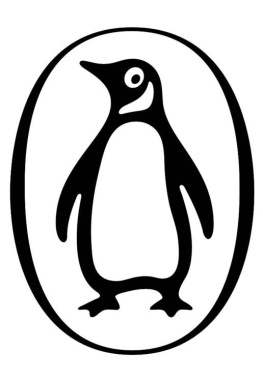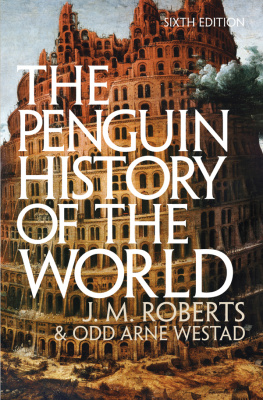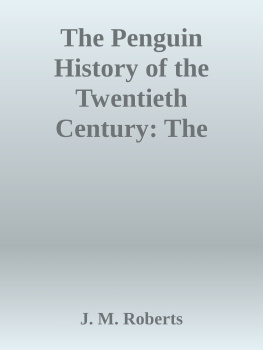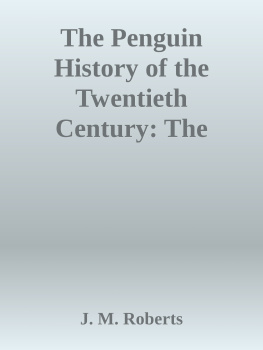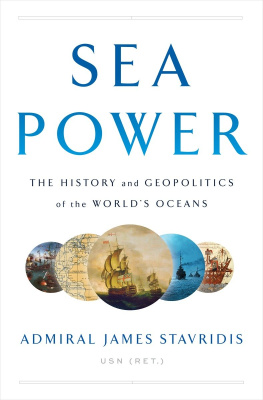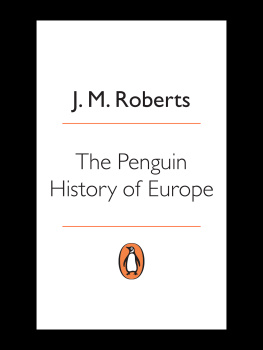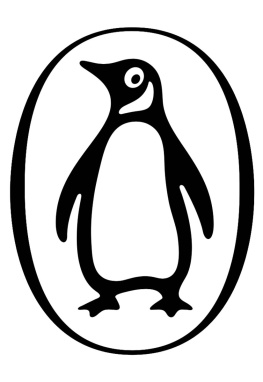PENGUIN BOOKS
THE NEW PENGUIN HISTORY OF THE WORLD
J. M. Roberts was born in Bath and educated at Taunton School and Keble College, Oxford. After National Service he returned to Oxford in 1950 and became a fellow of Magdalen the following year. In 1953 he went to the United States as Commonwealth Fund Fellow, the first of several visits to America during which he held, among other posts, those of Member of the Institute for Advanced Study, Princeton (1960), and visiting professorships at the University of South Carolina and Columbia University, New York. He was a Fellow and Tutor of Merton College, Oxford, from 1953 to 1979. From 1979 to 1985 he was Vice-Chancellor of Southampton University. He then returned to the Wardenship of Merton in 1985, from which he retired in 1994. In 1996 he was appointed CBE for services to education and history.
Dr Roberts edited the popular and successful partwork publication Purnells History of the Twentieth Century . From 1967 to 1976 he was joint editor of the English Historical Review . He is the author of Europe 18801945 , The Mythology of the Secret Societies , The Paris Commune from the Right , The Age of Revolution and Improvement and The French Revolution . In 1985 BBC2 transmitted the thirteen-part historical series The Triumph of the West , which Dr Roberts wrote and presented, and later in the year he published his book of the same title. He was historical adviser to the successful BBC television series Peoples Century .
Dr Roberts was also the author of The Penguin History of Europe and The Penguin History of the Twentieth Century . Dr Roberts died in May 2003.
Odd Arne Westad is Professor of International History at the London School of Economics. He is most recently the author of The Global Cold War , which won the Bancroft Prize.
J. M. ROBERTS
The New Penguin
History of the World
FIFTH EDITION
Updated and revised buy Odd Arne Westad

PENGUIN BOOKS
PENGUIN BOOKS
Published by the Penguin Group
Penguin Books Ltd, 80 Strand, London WC2R 0RL , England
Penguin Group (USA) Inc., 375 Hudson Street, New York, New York 10014, USA
Penguin Group (Canada), 90 Eglinton Avenue East, Suite 700, Toronto, Ontario, Canada M4P 2Y3
(a division of Pearson Penguin Canada Inc.)
Penguin Ireland, 25 St Stephens Green, Dublin 2, Ireland
(a division of Penguin Books Ltd)
Penguin Group (Australia), 250 Camberwell Road,
Camberwell, Victoria 3124, Australia (a division of Pearson Australia Group Pty Ltd)
Penguin Books India Pvt Ltd, 11 Community Centre,
Panchsheel Park, New Delhi 110 017, India
Penguin Group (NZ), 67 Apollo Drive, Rosedale, North Shore 0632, New Zealand
(a division of Pearson New Zealand Ltd)
Penguin Books (South Africa) (Pty) Ltd, 24 Sturdee Avenue,
Rosebank, Johannesburg 2196, South Africa
Penguin Books Ltd, Registered Offices: 80 Strand, London WC2R 0RL , England
www.penguin.com
First published in Great Britain as The Hutchinson History of the World by Hutchinson in 1976
First published in the United States of America, in slightly different form, as History of the
World by Alfred A. Knopf, Inc., 1976
Revised edition published as The Pelican History of the World in Pelican Books 1980
Reprinted with revisions 1983
Revised edition published by Hutchinson 1987
Published with revisions in Pelican Books 1988
Reprinted as The Penguin History of the World in Penguin Books 1990
Third revised edition published as History of the World by Helicon Publishing 1992
Published as The Penguin History of the World , without illustrations, in Penguin Books 1995
Fourth revised edition published as The New Penguin History of the World
by Allen Lane 2002
Published in Penguin Books 2004
Fifth edition published with revisions 2007
Copyright J. M. Roberts, 1976, 1980, 1983, 1987, 1988, 1992, 1997, 2002
Maps copyright Helicon Publishing Ltd., 1992
Revisions copyright Odd Arne Westad, 2007
All rights reserved
The moral right of the author has been asserted
Except in the United States of America, this book is sold subject
to the condition that it shall not, by way of trade or otherwise, be lent,
re-sold, hired out, or otherwise circulated without the publishers
prior consent in any form of binding or cover other than that in
which it is published and without a similar condition including this
condition being imposed on the subsequent purchaser
EISBN: 9780141900896
Contents
List of Maps
Preface to Fifth Edition
The first edition of this book appeared in 1976, and this is the fifth. There have also been several translations, whose texts have sometimes had to vary slightly from the English originals at the request of their publishers. I think that it is unlikely that I shall now have time to offer the public yet another version. Since, though, this contains a very substantial revision of the text after a comprehensive reconsideration it may be helpful to set out once more in a new preface some explanation of what I have tried to do, and why it seemed sensible to do it. At the very least, I feel I should indicate whether the events of over twenty-five years have led me to change the purposes and perspectives with which I set out to break the ground for this book in the late 1960s.
I have very recently heard it said of World History that everything changed, or something to that effect, on 11 September 2001. For reasons I have touched on briefly below, and because of certain ideas which have guided me from the outset, I think this is very misleading, untrue in any but a much qualified sense. Yet the first reason why a new edition seemed desirable is that world history for over a decade has been passing through and continues to pass through the most recent example of a recurrent phenomenon: a period of turbulent events and kaleidoscopic change. The beginnings of this confused and exciting period were already topics for the last, third, edition of this book, but events in the later 1990s alone made further consideration necessary in case new perspectives had to be taken into account, as well as new facts.
I feared the outcome would be a much enlarged book, but it did not turn out like that. Many changes of detail and style were required, but only the last section of the story underwent major rearrangement and reconstruction. Changes of emphasis were required, of course. There is a little more than in the last edition about recent changes in the position of women, about environmental concerns, about new institutions and assumptions, new questionings of old ones, and about shifts in the formal and informal basis of the international order (these topics are most marked in recent history, and my views on them can be found set out at greater length in my Penguin History of the Twentieth Century , published in 1999). But none of this reflected fundamental change in my standpoint or general outlook, and they can be summed up in much the same terms I have used before and from the outset.
Perhaps my predominant concern, from the start, was to show and recall to a non-specialist readership the weight of the historical past and the importance, even today, of historical inertia in a world we are often encouraged to think we can control and manage. Historical forces moulding the thinking and behaviour of modern Americans, Russians, Chinese, Indians and Arabs were laid down centuries before ideas like capitalism or communism were invented. Distant history still clutters our lives, and perhaps even some of what happened in prehistory is still at work in them, too. Yet there has always been tension between such forces and mankinds unique power to produce change. Only recently (it is a matter of a few centuries at most) in terms of the six thousand or so years of civilization which make up most of the subject-matter of this book there has also been a growing recognition of mankinds power as a change-maker. What is more, enthusiasm for technical advance now seems universal. Even if very recently indeed some have sought to temper this enthusiasm with qualifications, there is now a widespread notion that most problems can and will be solved by human agency.
Next page
